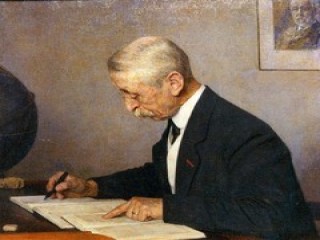
Jacobus Kapteyn biography
Date of birth : 1851-01-19
Date of death : 1922-06-18
Birthplace : Barneveld, Gelderland, Netherlands
Nationality : Dutch
Category : Arhitecture and Engineering
Last modified : 2011-07-05
Credited as : Astronomer, Milky Way, evidence for galactic rotation
Jacobus Kapteyn was born on Jan. 19, 1851, in Barneveld. At 18 he entered the University of Utrecht and 6 years later obtained his doctorate in physics. He became a professional astronomer somewhat accidentally: just as he received his doctoral degree, the position of observer at the Leiden Observatory became vacant. He applied and obtained it, a decisive event in his life, for it appears likely that it was during his subsequent 3 years at Leiden that he resolved to try to understand the structure of the universe. In 1878 he became professor of astronomy, calculus of probabilities, and theoretical mechanics at the University of Groningen. The following year he married Catharina E. Kalshoven; they had three children.
The University of Groningen had no observatory, and for years Kapteyn unsuccessfully attempted to secure funds to establish one. However, he found a unique solution to the problem: in 1896 he established at Groningen not an observatory but a laboratory, where stellar photographs taken elsewhere could be analyzed. In 1903, after several years at a temporary location, his laboratory found a permanent home in the mineralogical laboratory of the university; it is now known as the Astronomical Laboratory Kapteyn.
In 1885 Kapteyn took upon himself a prodigious task: he offered to help David Gill measure and reduce the photographs Gill had taken of the southern sky from his observatory at the Cape of Good Hope. The project took 14 years. The resulting star catalog contained almost a half million entries; this work alone would have put generations of astronomers in Kapteyn's debt.
By 1889 Kapteyn had developed new methods for determining stellar parallaxes, or distances. This work soon evolved into studies on stellar proper motions, and by 1896 he found indications that, contrary to accepted belief, stars do not move about at random in space. By 1904-1905 he had proof that they do not. He discovered, by photographically sampling limited portions of the night sky—a technique that made him the founder of modern statistical astronomy—that stars tend to move in two diametrically opposed directions in our galaxy, the Milky Way, toward the constellations Orion and Scutum. His discovery of these two "star streams" was one of the most significant astronomical discoveries ever made.
While it was not until much later that a correct explanation of the star streams was offered, it was immediately obvious to Kapteyn that it was of the greatest importance for understanding the structure of the universe. Accordingly, in 1906 he proposed the Kapteyn Plan of Selected Areas for enlisting the help of astronomers throughout the world to determine the apparent magnitudes, parallaxes, spectral types, proper motions, and radial velocities of as many stars as possible in over 200 patches of sky. On the basis of the results he proposed a model of our galaxy, now known as the Kapteyn universe. The solar system was pictured to be nearly centrally embedded in a dense, almost ellipsoidal, concentration of stars which thinned out rapidly a few thousand light-years (a relatively small distance in astronomy) away from the center.
Between 1908 and 1914 Kapteyn was a research associate at Mt. Wilson Observatory in southern California during the summers. He died in Amsterdam on June 18, 1922.
















